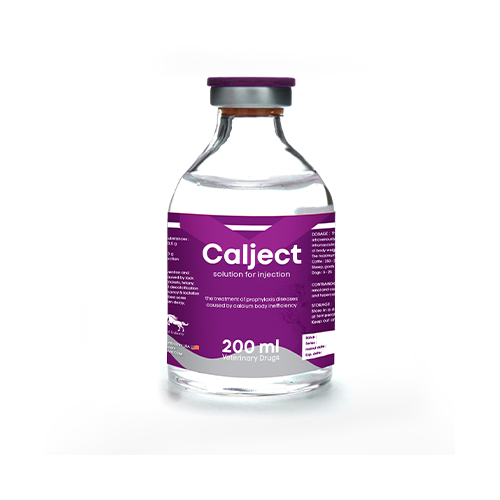
COMPOSITION:
100 ml contains active substances (g):
Calcium gluconate – 20,0 g
Boric acid – 1,8 g
Sodium tetraborate – 1,3 g
PHARMACOLOGICAL CHARACTERISTICS:
- Increase in Blood Calcium Levels: It elevates the concentration of calcium in the bloodstream.
- Desensitizing and Anti-Toxic Actions: Calcium Borogluconate has properties that reduce sensitivity to stimuli and counteract toxins.
- Anti-Inflammatory Effects: It helps alleviate inflammation.
- Reduction in Capillary Permeability: It decreases the leakage of fluids from capillary vessels.
- Stimulation of Metabolism: It boosts metabolic processes in the body.
- Strengthening of Heart Muscle: It enhances the function and strength of the heart muscle.
- Activation of Reticuloendothelial System: It activates the body’s defense system and enhances the ability of certain cells to engulf and destroy foreign particles.
- Fast Absorption and Distribution: After injection, the active substances are rapidly absorbed from the injection site and distributed throughout the body’s organs and tissues.
- Non-Irritating: Calcium Borogluconate does not cause irritation at the injection site and is well-tolerated by the body.
Understanding these pharmacological characteristics helps in comprehending the drug’s mechanisms of action and potential therapeutic effects.
APPLICATION :
The application of the drug encompasses various conditions and situations, including:
- Prevention and Treatment of Calcium Deficiency-Related Diseases: Such as rickets, tetany, osteomalacia, decalcification during pregnancy and lactation, prenatal and postnatal bed sores, postpartum paresis, delayed labor, and postpartum eclampsia.
- Management of Inflammatory Processes: Including pneumonia, peritonitis, pleurisy, nephritis, endometritis, metritis, and rheumatic inflammation of horses’ hooves.
- Treatment of Allergic Diseases and Shock: Effective for conditions like rash, serum sickness, and allergic reactions, as well as in cases of shock and transport disease.
- Management of Edema and Congestion: Addresses conditions such as pulmonary edema, laryngeal edema, and edema disease in pigs.
- Treatment of Hypotonia and Atony: Helps in cases of proventricular hypotonia and atony in cattle.
- Antidote for Poisoning: Acts as an antidote in poisoning by magnesium salts, oxalic acid, soluble salts of oxalic and fluorine acids, as well as toxic liver damage and toxic pulmonary edema.
- Hemostatic Agent: Effective in controlling bleeding, including nasal, gastrointestinal, lung, uterine, and postoperative bleeding, as well as hemorrhagic diathesis.
The drug’s versatility makes it valuable in addressing a wide range of medical conditions and emergencies in veterinary medicine.
DOSAGE:
The dosage guidelines for the drug are as follows:
- Route of Administration: The drug can be administered once intravenously (slowly), subcutaneously, or intramuscularly.
- Dosage: Administer at a dose of 0.5 ml per 1 kg of body weight.
- Maximum Single Dose:
- Cattle: 250-300 ml
- Horses: 150-200 ml
- Sheep, Goats: 50-100 ml
- Pigs: 30-100 ml
- Dogs: 5-25 ml
- Cats: 2-10 ml
- Repeat Dose: If necessary, the drug can be administered repeatedly at the same dose after 24 hours.
- Intravenous Injection: If administering intravenously, the drug should be heated to the body temperature of the animal and injected slowly.
- Subcutaneous and Intramuscular Injection: When administering subcutaneously or intramuscularly, the drug should be divided and injected into different areas of the body to ensure proper absorption and minimize discomfort.
Following these dosage and administration guidelines will help ensure effective treatment while minimizing the risk of adverse effects.
CONTRAINDICATION:
- Renal Disease: Avoid use in animals with renal (kidney) disease, as the drug may exacerbate existing renal conditions or interfere with kidney function.
- Cardiovascular Disease: It is contraindicated in animals with cardiovascular (heart) disease, as it may worsen heart conditions or lead to cardiovascular complications.
- Hypercalcemia: Do not use in cases of hypercalcemia, which is an elevated level of calcium in the bloodstream. Administering the drug in such cases can further increase calcium levels, leading to potential complications.
Adhering to these contraindications helps ensure the safety and effectiveness of the drug’s use in veterinary practice.
PRECAUTIONS:
- Temperature and Injection Speed: Before intravenous injection, heat the drug to the animal’s body temperature and administer it slowly to prevent adverse reactions.
- Dose Limitation: Ensure not to exceed the recommended dose to avoid potential overdosing and associated complications.
- Subcutaneous Injection: Expect minor swelling at the injection site following subcutaneous administration, which typically resolves within 1-2 hours.
- Injection Sites: When administering subcutaneously or intramuscularly, inject the drug into different areas of the body to distribute it effectively and prevent localized irritation.
- Drug Interactions: Avoid using the drug concurrently with cardiac glycosides and tetracycline antibiotics, as interactions between these medications may occur.
- Avoid Simultaneous Use: Do not use the drug simultaneously with foxglove and Strophanthus glycosides, as this combination may lead to adverse effects or reduced efficacy of either medication.
Adhering to these precautions helps ensure the safe and effective use of the drug in veterinary practice.
PACKAGING :
Glass bottles, 100, 200 and 500 ml.
STORAGE:
Dry, dark, inaccessible to children or animals place, away from food and feed, at a temperature from 5°C to 25°C.
FOR VETERINARY USE ONLY!
